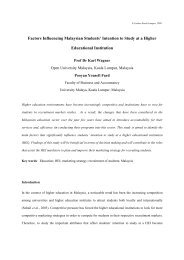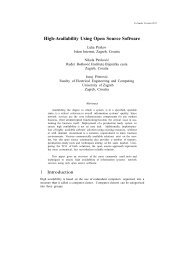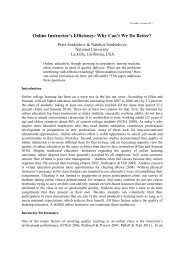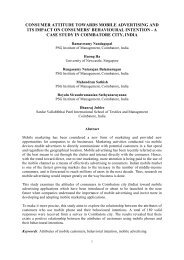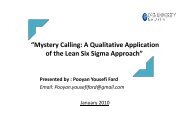Organizational Culture as a Source of Competitive Advantage - CASA
Organizational Culture as a Source of Competitive Advantage - CASA
Organizational Culture as a Source of Competitive Advantage - CASA
Create successful ePaper yourself
Turn your PDF publications into a flip-book with our unique Google optimized e-Paper software.
E-Leader Bangkok, 2008<br />
“Firms pursuing a “high road” strategy b<strong>as</strong>ed on service, quality, or product differentiation<br />
need to follow high-involvement or high commitment sets <strong>of</strong> management practices; those<br />
firms pursuing a strategy b<strong>as</strong>ed on cost-minimization should pursue a more controloriented,<br />
Tayloristic strategy.” (Pfeffer, p. 56,1998).<br />
This perspective suggests not only that organizational effectiveness depends on the fit between strategy<br />
type and culture but also that managers must create the appropriate structures, systems, technologies, and<br />
human resource capabilities (skills and qualities) to communicate and reinforce behavioral norms that are<br />
supportive <strong>of</strong> the strategy (Cabrera & Bonache, 1999). These factors are critical for shaping the firm’s<br />
operating culture and rendering it complementary to the strategy being implemented.<br />
This contingency approach to strategic management, however, is inconsistent with adaptive theories <strong>of</strong><br />
culture (Kotter & Heskett, 1992), which propose that high involvement and flexible cultures are appropriate<br />
for all types <strong>of</strong> organizations. Empirical support h<strong>as</strong> been provided for this position by a series <strong>of</strong> studies<br />
employing survey-b<strong>as</strong>ed me<strong>as</strong>ures <strong>of</strong> organizational culture. For example, research by Cooke and Szumal<br />
(2000), Glisson and James (2002), and others h<strong>as</strong> suggested that Constructive cultures (which promote<br />
adaptability) are consistently related to effectiveness and P<strong>as</strong>sive/Defensive and Aggressive/Defensive<br />
cultures (which detract from adaptability) are either unrelated or negatively related to effectiveness. This<br />
inconsistency can be exemplified by considering the two distinct types <strong>of</strong> strategies proposed by Miles and<br />
Snow (1984): (1) “prospector” strategies, which involve gaining advantage by producing innovative and<br />
high quality products and (2) “defender” strategies, which involve cost leadership and gaining advantage by<br />
producing at a low cost. On the one hand, prospector strategies call for the high-involvement management<br />
and human resource practices that reinforce the type <strong>of</strong> adaptive and constructive cultures that Kotter and<br />
Heskett view <strong>as</strong> effective. On the other hand, defender strategies call for control-oriented practices that<br />
reinforce non-adaptive and defensive cultures that have been shown to be less effective (Cooke & Szumal,<br />
2000). Porter (1990, 1985) proposes a similar dichotomous set <strong>of</strong> strategic types, which he labeled<br />
“differentiation” versus “low-cost.” Though defensive cultures may facilitate the implementation <strong>of</strong><br />
defender or low-cost strategies, they simultaneously have a negative impact on individuals and teams,<br />
which, in turn, is likely to suppress organizational performance regardless <strong>of</strong> the proposed “fit” between<br />
strategy type and culture. The present study does not intend to resolve this inconsistency in the literature<br />
but instead focuses on the relationship between type <strong>of</strong> business strategy and culture while emph<strong>as</strong>izing<br />
effects at the unit (or work group) and individual levels.<br />
Background <strong>of</strong> <strong>Organizational</strong> <strong>Culture</strong><br />
<strong>Organizational</strong> culture h<strong>as</strong> been defined in many different ways in the literature, but most definitions have<br />
tended to focus on shared values, beliefs, behavioral norms and the artifacts that are present in<br />
organizations (Schein, 1985; Sathe, 1983; Cooke & Rousseau, 1988). The literature h<strong>as</strong> emph<strong>as</strong>ized the<br />
importance <strong>of</strong> system-level behavioral expectations and empirical studies have examined the patterns <strong>of</strong><br />
behavior that result from shared meanings.<br />
Constructive cultures, <strong>as</strong> defined and operationalized in Cooke and Lafferty’s (1987) <strong>Organizational</strong><br />
<strong>Culture</strong> Inventory (OCI), encourage members to be, among other things, flexible and adaptive in response<br />
to changing environmental conditions. Constructive cultures are those in which members are encouraged<br />
to interact with others and approach their work in ways that will help them meet their higher order<br />
satisfaction needs. These cultures are characterized by norms and expectations for Achievement, Self-<br />
Actualizing, Humanistic/Encouraging, and Affiliative behaviors (Cooke & Szumal, 1993, p. 1302). While<br />
Constructive cultures promote individual motivation, cooperation and collaboration, and adaptability,<br />
Defensive cultures, in contr<strong>as</strong>t, promote or implicitly require behaviors that work against adaptability. The<br />
<strong>Organizational</strong> <strong>Culture</strong> Inventory distinguishes between two sets <strong>of</strong> Defensive cultures: P<strong>as</strong>sive/Defensive<br />
and Aggressive/Defensive. P<strong>as</strong>sive/Defensive cultures, in which members believe they must interact with<br />
people in ways that will not threaten their own security, are characterized by norms and expectation for<br />
Approval-oriented, Conventional, Dependent, and Avoidant behaviors. Aggressive/Defensive cultures, in<br />
which members are expected to approach t<strong>as</strong>ks in forceful ways to protect their status and security, are<br />
characterized by Oppositional, Power-oriented, <strong>Competitive</strong> and Perfectionistic norms (Cooke & Szumal,<br />
1993).<br />
2


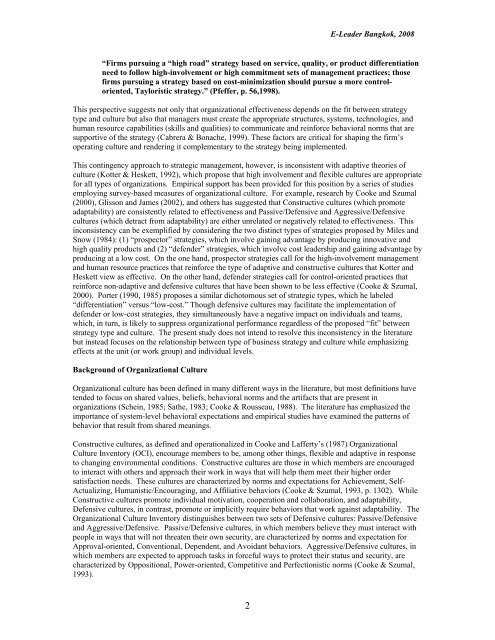
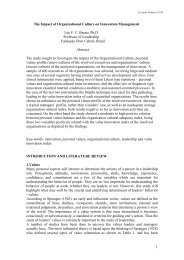
![Oberholzer [Compatibility Mode].pdf - CASA](https://img.yumpu.com/21081507/1/190x135/oberholzer-compatibility-modepdf-casa.jpg?quality=85)


